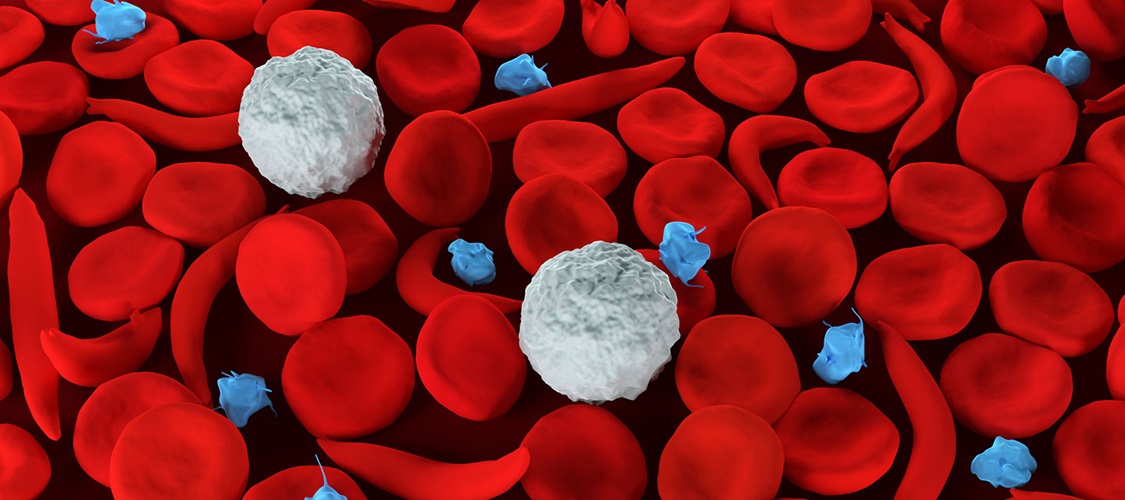Sickle Cell Disease
What is sickle cell disease?
Sickle cell disease is an inherited blood disorder. It is marked by flawed hemoglobin. That’s the protein in red blood cells that carries oxygen to the tissues of the body. So, sickle cell disease interferes with the delivery of oxygen to the tissues.
Red blood cells with normal hemoglobin are smooth, disk-shaped, and flexible, like doughnuts without holes. They can move through the blood vessels easily. Cells with sickle cell hemoglobin are stiff and sticky. When they lose their oxygen, they form into the shape of a sickle or crescent, like the letter C. These cells stick together and can’t easily move through the blood vessels. This can block small blood vessels and the movement of healthy, normal oxygen-carrying blood. The blockage can cause pain.
Normal red blood cells can live up to 120 days. But, sickle cells only live for about 10 to 20 days. Also, sickle cells may be destroyed by the spleen because of their shape and stiffness. The spleen helps filter the blood of infections. Sickled cells get stuck in this filter and die. With less healthy red blood cells circulating in the body, you can become chronically anemic. The sickled cells also damage the spleen. This puts you are at greater at risk for infections.
What causes sickle cell disease?
Sickle cell is an inherited disease caused by a defect in a gene.
- A person will be born with sickle cell disease only if two genes are inherited—one from the mother and one from the father.
- A person who inherits just one gene is healthy and said to be a "carrier" of the disease. A carrier has an increased chance of having a child with sickle cell disease if he or she has a child with another carrier.
For parents who are each carriers of a sickle cell gene, there is a 1 in 4, or a 25 % chance of having a child with sickle cell disease.
What are the risk factors for sickle cell disease?
Having a family history of sickle cell disease increases your risk for the disease. In the United States, it mainly affects African Americans.What are the symptoms of sickle cell disease?
The following is a list of symptoms and complications associated with sickle cell disease. However, each person may experience symptoms differently. Symptoms and complications may include:
- Anemia. Because sickled cells are short-lived or destroyed, there are less red blood cells available in the body. This results in anemia. Severe anemia can make you feel dizzy, short of breath, and tired.
- Pain crisis, or sickle crisis. This occurs when the flow of blood is blocked to an area because the sickled cells have become stuck in the blood vessel. The pain can occur anywhere, but most often occurs in the chest, arms, and legs. Infants and young children may have painful swelling of the fingers and toes. Interruption in blood flow may also cause tissue death.
- Acute chest syndrome. This occurs when sickling occurs in the chest. This can be life-threatening. It often occurs suddenly, when the body is under stress from infection, fever, or dehydration. The sickled cells stick together and block the flow of oxygen in the tiny vessels in the lungs. It resembles pneumonia and can include fever, pain, and a violent cough.
- Splenic sequestration (pooling). Crises are a result of sickle cells pooling in the spleen. This can cause a sudden drop in hemoglobin and can be life-threatening if not treated promptly. The spleen can also become enlarged and painful from the increase in blood volume. After repeated episodes, the spleen becomes scarred, and permanently damaged. Most children, by age 8, do not have a working spleen either from surgical removal, or from repeated episodes of splenic sequestration. The risk of infection is a major concern of children without a working spleen. Infection is the major cause of death in children younger than age 5 in this population.
- Stroke. This is another sudden and severe complication of people with sickle cell disease. The misshapen cells can block the major blood vessels that supply the brain with oxygen. Any interruption in the flow of blood and oxygen to the brain can result in severe brain damage. If you have one stroke from sickle cell anemia, you are more likely to have a second and third stroke.
- Jaundice, or yellowing of the skin, eyes, and mouth. Jaundice is a common sign and symptom of sickle disease. Sickle cells do not live as long as normal red blood cells and, therefore, they are dying faster than the liver can filter them out. Bilirubin (which causes the yellow color) from these broken down cells builds up in the system causing jaundice.
- Priapism. This is a painful obstruction of the blood vessels in the penis by sickle cells. If not promptly treated, it can result in impotence.
The symptoms of sickle cell disease may look like other blood disorders or medical problems. Always consult your health care provider for a diagnosis.
How is sickle cell disease diagnosed?
Along with a complete medical history and physical exam, you may have blood and other tests.
Many states routinely screen newborns for sickle cell so that treatment can begin as soon as possible. Early diagnosis and treatment can reduce the risk of complications.
Hemoglobin electrophoresis is a blood test that can determine if a person is a carrier of sickle cell, or has any of the diseases associated with the sickle cell gene.
How is sickle cell disease treated?
Your doctor will consider your age, overall health and other factors when determining the best treatment for you.
Early diagnosis and prevention of complications is critical in sickle cell disease treatment. Treatment aims to prevent organ damage including strokes, prevent infection, and treat symptoms. Treatment may include:
- Pain medications. This is for sickle cell crises.
- Drinking plenty of water daily (8 to 10 glasses). This is to prevent and treat pain crises. In some situations, intravenous fluids may be required.
- Blood transfusions. These may help treat anemia and prevent stroke. They are also used to dilute the sickled hemoglobin with normal hemoglobin to treat chronic pain, acute chest syndrome, splenic sequestration, and other emergencies.
- Vaccinations and antibiotics. These are used to prevent infections.
- Folic acid. Folic acid will help prevent severe anemia.
- Hydroxyurea. This medication helps reduce the frequency of pain crises and acute chest syndrome. It may also help decrease the need for blood transfusions. The long-term effects of the medication are unknown.
- Regular eye exams. These are done to screen for retinopathy.
- Bone marrow transplant. Bone marrow transplants can cure some people with sickle cell disease. The decision to have this procedure is based on the severity of the disease and ability to find a suitable bone marrow donor. These decisions need to be discussed with your doctor and are only done at specialized medical centers.
What are the complications of sickle cell disease?
Any and all major organs are affected by sickle cell disease. The liver, heart, kidneys, gallbladder, eyes, bones, and joints can suffer damage from the abnormal function of the sickle cells and their inability to flow through the small blood vessels correctly. Problems may include the following:
- Increased infections
- Leg ulcers
- Bone damage
- Early gallstones
- Kidney damage and loss of body water in the urine
- Eye damage
- Multiple organ failure
Living with sickle cell disease
Sickle cell disease is a life-long condition. Although the complications of sickle cell disease may not be able to be prevented entirely, living a healthy life-style can reduce some of the complications.
It is important to eat a healthy diet with lots of fruits, vegetables, whole grains, and protein, and drink lots of fluids.
Do not take decongestants because they cause constriction of blood vessels and could trigger a crisis.
Other factors that may trigger a crisis include high altitudes, cold weather, swimming in cold water, and heavy physical labor.
Avoid infections by getting an annual flu shot, washing your hands frequently, avoiding those who are sick, and getting regular dental exams.
Key points
- Sickle cell disease is an inherited blood disorder marked by defective hemoglobin.
- It inhibits the ability of hemoglobin in red blood cells to carry oxygen.
- Sickle cells tend to stick together, blocking small blood vessels causing painful and damaging complications.
- Sickle cell disease is treated with pain medications as needed, drinking 8 to 10 glasses of water each day, blood transfusions, and medications.
Next steps
Tips to help you get the most from a visit to your health care provider:
- Before your visit, write down questions you want answered.
- Bring someone with you to help you ask questions and remember what your provider tells you.
- At the visit, write down the names of new medicines, treatments, or tests, and any new instructions your provider gives you.
- If you have a follow-up appointment, write down the date, time, and purpose for that visit.
- Know how you can contact your provider if you have questions.




